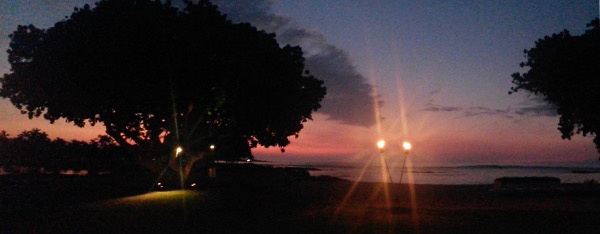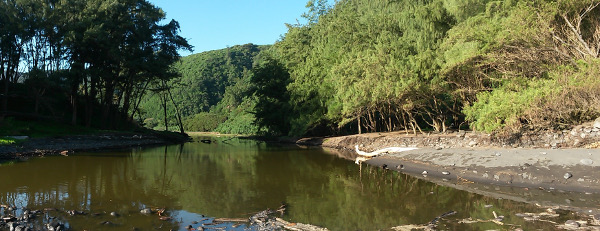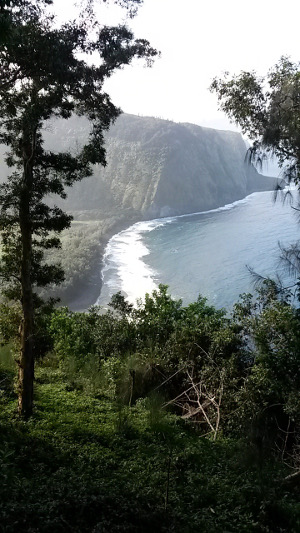Imagine a camp site fire pit, where you gather up to tell stories and watch ambers glows warmly and spewing smokes up to the sky. Now imagine that pit 10 times the size of a football field.

On our way from the highway, I saw a red glow on the near horizon. “What’s that? Wild fire?†“No,†our local friend said. “That’s the volcano that I am taking you to.†I was dumbfounded. About 15 minutes later, we pulled into the Kilauea Outlook at Volcano National Park and I was staring at that biggest campfire a couple of miles away. This is clearly not a volcano that buried ancient cities or St. Helen that blew up her top. This is a real erupting volcano as mild as the warmth of the campfire. It is really best, as our friend said, to come here after dark.
Hawaiian volcanoes, though live, are not violent. The lava flow may destroy properties, but rarely kill. Hawaiian think of volcanoes as blessings that give new land and, thus, new lives. This Kilauea volcano has been very active and producing impressive lava flow which inspired many photographers.
And the stars! I saw all of the Orion, not just the belt. I saw milky way and the whole sky full of stars. I didn’t remember so many stars since my country-side childhood years. Stars were such a treat for this Seattle city dweller who would be lucky to see the moon.

Yes, I am in Hawaii. Ah…

Next morning, 6:30am, the parking lot was already full. We joined the small crowd waiting, at the trailhead of Pololu Valley, for the sunrise. The earth woke up with this breathtaking light-show which was also the starting gun for the mile-long hike. The destination was a black sand beach at the mouth of a serene creak. The lush meadow lured you to roam, linger, lie down, and think retirement. Then, inevitably, we started the hike-up, about 1000 feet back up. The morning cool was long replaced by the sweat producing tropical sun. At the top, we were rewarded by the gentle sea breeze and the expanse of the ocean view, now in full brightness.

Waipio Valley is the southern tip of the Pu’u O Umi Reserve, as Pololu Valley the northern tip. It was interesting that these two are apart, as crow’s flight, for about just 2 miles, but the crossing, on foot, involves probably a whole day’s vigorous hike up and down several valleys. In the old days, natives probably simply row over in canoes.
What’s a Hawaiian vacation without an ocean-side meal? The secret, guided by a local, is to get food-truck BBQ, another food-truck fish-and-chip, a nice cup of shaved ice, and picnic at Spencer Beach. After the feast and a bit lazing around, we jumped into the ocean and snorkeled around to work out the lunch.
As Canoe House table was not yet ready, we waited at the pool bar of Mauna Lani Hotel. What a gem! Delicious foods came inside Chinese bamboo steamers, to keep warm and, I guess, covered. The obligatory Mai Tai did not come with a little umbrella, thank god, and was strongly mixed with good rums. The best part of this place was the sunset. Gorgeous colors contrasted with the Tiki torches. We hang and chilled for hours.
Poké seemed to be in rave these day. One of the neighbors was a fisherman. Whenever he had a good catch, the family made Poké (Ahi with Avocado on top of home-fried nacho chips) and sold them from the garage-top patio. Cheap, fresh, delicious, and friendly. It pretty much became a day-long spontaneous block party.

Big Island is a very different Hawaii than Oahu and Maui, where tourism dominates pretty much everything. Here you interact with local residents. Since everyone is pretty much an immigrant, there are lots of stories and genuine friendliness. Jack Tottle is a renown Bluegrass musician. (“What’s the exact definition of Bluegrass? Jack.†“According to Louis Armstrong, if you need definition, then you wouldn’t know what’s Jazz. That goes with Bluegrass as well.â€) He is now a retired plantation owner. (“I believe you would be called a ‘gentleman farmer.’ Right?†“Yes, I own a farm but I don’t farm.â€) His multi-acre plantation has hundreds of Macadamia nut trees. We walked up to one such tree and picked a cracked nut off. To eat, we must walked back to the house and use a vise to crack it open. That’s when I notice a bucket of nuts next to the nut cracker. Jack’s wife was busy dividing up a bunch of just ripe banana, harvested a couple of days ago. Knowing where we grew up, she insisted showing us the Star-fruit tree. When we left, the trunk was full of citric, at least 10 pounds of banana, and another 15 pounds of Star-fruits. That’s after we begged off the Papaya, lemons, and nuts.
This island has the balance of touristy pampering and natural beauty. It is a serious consideration for a vacation home, obviously a dream waiting for the winning lottery ticket.
